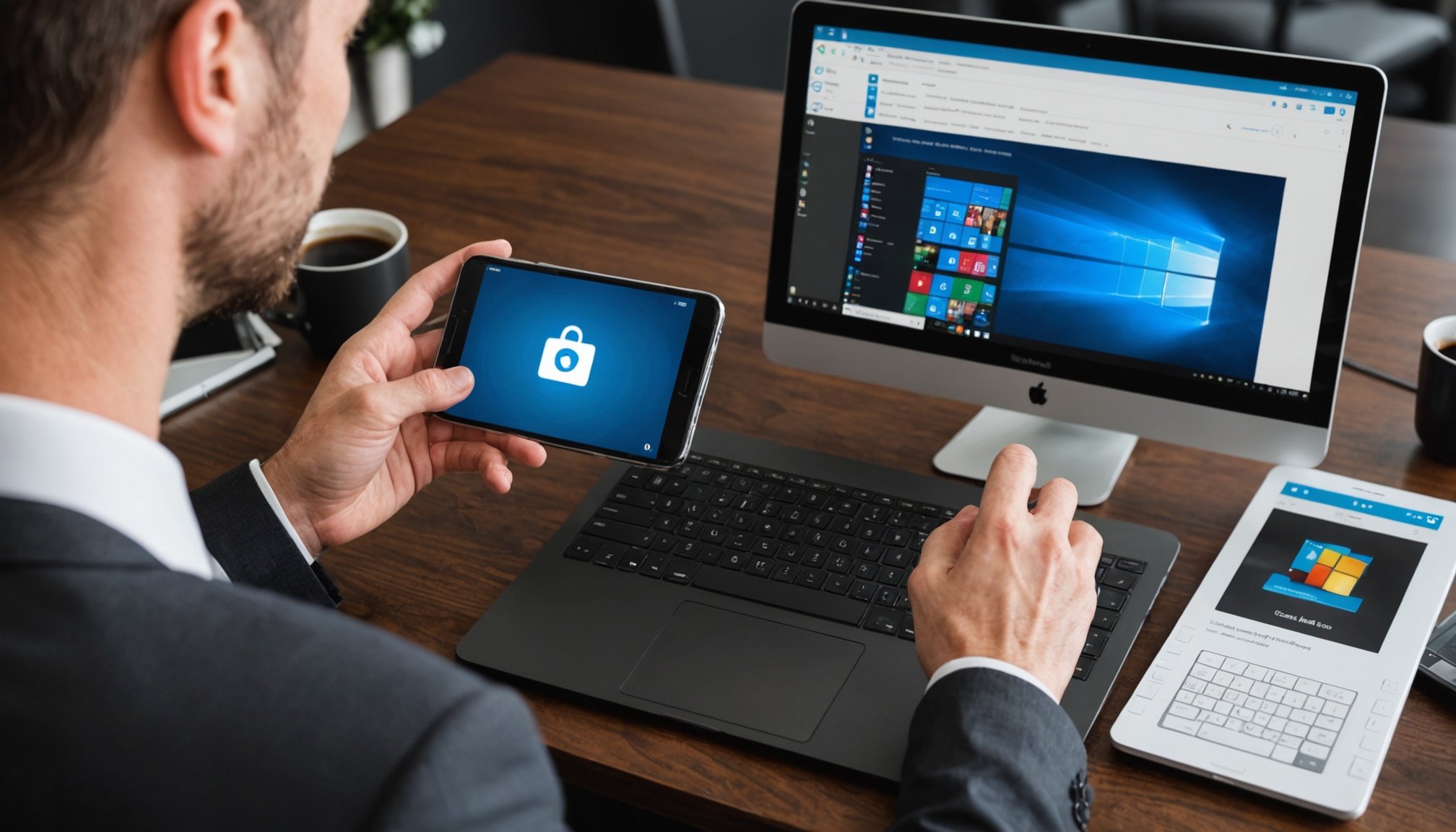Overview of Remote Desktop Access
Remote Desktop Access is an essential feature that allows users to control a computer from a different location. This capability is crucial for leveraging the power of your smartphone to access and manage desktop environments from afar. It facilitates a seamless union between mobile devices and computers, thus transforming how we work and interact with technology.
Use Cases for Remote Desktop Access
The use of remote control through smartphones includes a variety of practical applications. For instance, professionals can easily access files, manage servers, or troubleshoot issues without physically being present in the office. In education, students can participate in virtual labs or access specific classroom software required for their studies. Additionally, remote support consultants find it incredibly beneficial for assisting clients by accessing their systems directly and resolving issues efficiently.
Additional reading : The Complete Handbook to Effortless Multi-Device Management: Harness Your Smartphone’s Potential for Seamless Ecosystem Control
Key Advantages of Mastering Remote Desktop Access
Understanding remote desktop access grants numerous advantages.
- Flexibility: Allows work from virtually anywhere, promoting a highly adaptable work environment.
- Efficiency: Reduces the need for travel, saving time and resources.
- Productivity: Provides immediate access to necessary tools and information, enhancing workflow continuity.
Mastering this technology is not just a convenience; it is increasingly becoming a necessity in today’s fast-paced, digital-centric world.
In the same genre : Find your perfect refurbished iphone in Canada now
Tools and Software for Remote Desktop Access
Understanding the array of available Remote Access Tools and Remote Desktop Software is crucial for anyone looking to leverage remote control capabilities. These applications enable users to connect their smartphones to computers seamlessly, providing a range of functionalities catering to different needs and platforms.
Top Software Options
Several software options exist, each offering unique features. TeamViewer and AnyDesk are popular choices due to their user-friendliness and cross-platform compatibility, allowing for both Windows and Mac OS connections. For those focused on security alongside ease of use, Chrome Remote Desktop and Microsoft Remote Desktop are notable mentions, offering robust security protocols while providing a seamless user experience.
Operating System Compatibility
When choosing a remote access tool, consider its compatibility with various operating systems. This ensures that transitions between devices and platforms remain smooth. For iOS users, specific software solutions may provide better integration with Apple ecosystems, whereas Android users might find flexibility in other options that offer broad connectivity features.
Features to Look For
When selecting a remote desktop application, certain features are fundamental: high connection stability, data encryption, user-friendly interfaces, and multi-screen support. These elements significantly impact the overall user experience by ensuring reliable connections, enhanced security, and ease of use, making managing tasks remotely more efficient and secure.
Step-by-Step Guide to Setting Up Remote Access
Establishing Remote Desktop Access effectively on your device can be streamlined with proper guidance. Here’s a detailed rundown for both Android and iOS users, aiming for a hassle-free experience.
Initial Setup for Android and iOS Devices
For Android users, start by downloading a suitable Remote Access Tool from the Google Play Store. Popular choices include Microsoft’s Remote Desktop or TeamViewer. Open the application, and follow the on-screen instructions for linking your smartphone to your computer.
For iOS devices, head to the App Store and download applications like Chrome Remote Desktop or AnyDesk. These applications provide a user-friendly interface tailored for Apple’s ecosystem, simplifying the setup process.
Step-by-step Configuration
- Download and install your chosen Remote Desktop Software on both your smartphone and computer.
- On your computer, configure settings to allow remote connections, often found in the system preferences or settings menu.
- Open the application on your smartphone and enter the necessary credentials or codes to connect to your computer.
- Test the connection to ensure reliability and function.
Tips for Smooth Connection
- Ensure both devices are using a stable internet connection.
- Regularly update software on both devices for optimal performance and security.
- Configure necessary permissions carefully during setup to avoid interruptions during sessions.
Advanced Techniques for Optimizing Remote Access
Implementing Advanced Remote Access techniques can result in significant performance improvements and a more robust user experience.
Speed and Connection Stability
To achieve optimal speed and connection stability, ensure that both devices are connected to high-speed internet. Utilising wired connections where possible can minimise latency. Reducing unnecessary background applications on both the smartphone and the computer can also help maintain smooth communication. Prioritising your remote access application’s traffic using Quality of Service (QoS) settings on your router can result in significant stability improvements.
Customization Options
Customising features in remote access applications can significantly enhance usability. Tailor keyboard shortcuts for efficiency and adjust display settings for optimal compatibility with different devices. For smartphone access, scaling the desktop view can make navigation easier, especially on smaller screens. Many applications offer gesture controls, transforming smartphone access into a more intuitive experience.
Advanced Security Measures
Adopting advanced security protocols is critical for protecting data during remote sessions. Implement end-to-end encryption and ensure that two-factor authentication is enabled. Regularly update your remote desktop software and operating system to mitigate vulnerabilities. For heightened security, consider using a Virtual Private Network (VPN) to add an extra layer of protection to your connections.
Troubleshooting Common Issues
Encountering problems with remote desktop access can be frustrating, but armed with an understanding of common issues, you can resolve them efficiently. Start by identifying frequent problems such as connectivity failures and sluggish performance. Connectivity issues often arise due to unstable internet connections. Ensure both devices are connected to a strong network, checking routers and network settings if necessary.
If experiencing lag or delays, close unnecessary applications on your smartphone and computer to free up resources. This can enhance performance by reducing load. Additionally, ensure your remote access software is updated to the latest version to leverage optimal functionality and security patches.
When faced with persistent problems beyond your expertise, a systematic approach is essential. First, consult in-app help resources or online forums dedicated to your specific remote desktop application. These can offer insights or solutions from others who faced similar challenges. If troubleshooting persists without resolution, seeking professional support might be necessary. Contacting software support teams can provide specialized assistance tailored to your needs.
Adopting structured problem-solving strategies can mitigate issues efficiently, allowing for smoother and more effective use of remote access in your digital tasks. Understanding these techniques ensures you remain productive, despite technological hiccups.
Security Considerations for Remote Access
In any remote desktop access scenario, prioritising security is crucial to protect sensitive data and maintain system integrity. Understanding best practices and equipping yourself with the right tools can vastly improve your data protection.
Best Practices for Security
To ensure safe remote access, begin by implementing two-factor authentication, which adds a necessary layer of verification beyond simple passwords. Regularly update both your remote desktop software and operating systems to protect against vulnerabilities. Additionally, create strong, unique passwords for each access point and change them periodically.
Risks and How to Mitigate Them
Common security risks include unauthorised access and data breaches. Mitigate these by using a Virtual Private Network (VPN) to encrypt your connection, ensuring that data is secure while in transit. Employing end-to-end encryption features available within remote access tools also prevents interception by malicious entities.
Tools for Enhancing Security
For enhancing the security of your remote sessions, integrate tools such as firewalls and antivirus software. These provide robust protection against unwanted intrusions and cyber threats. Employing comprehensive security suites specifically designed for remote access can offer additional features, like real-time threat assessment and intrusion detection systems, to bolster your security infrastructure.
Visual Aids and Resources
Understanding the intricacies of Remote Desktop Access can be significantly enhanced with Visual Aids. These tools not only depict complex setups and configurations clearly but also cater to different learning styles, making the learning process more engaging. Videos and diagrams serve as excellent supplements, especially for those who absorb information visually.
Videos and Online Courses
Videos provide a step-by-step visual guide, demonstrating smartphone access setups and troubleshooting steps in action. Platforms like YouTube host educational content detailing configuration steps, turning intricate processes into digestible, straightforward tutorials. Online courses on platforms such as Coursera or Udemy offer structured learning pathways, ideal for anyone seeking an in-depth understanding of remote control technologies.
Suggested Reading Materials
For those who prefer reading, numerous eBooks and guides delve deeper into the theory and applications of remote desktop access. Such materials cover foundational concepts and offer insights into advanced optimization techniques. Books often provide detailed explanations and case studies, equipping readers with the knowledge needed to harness these tools effectively.
Leveraging these resource recommendations ensures a more comprehensive grasp of remote access technologies, encouraging users to master both basic and advanced concepts with confidence.











